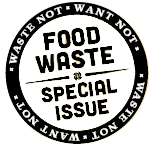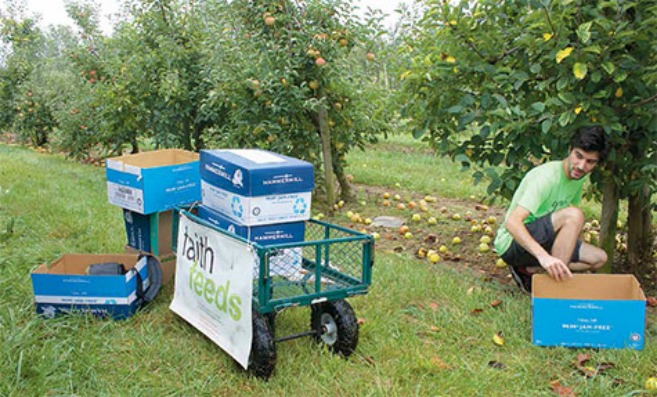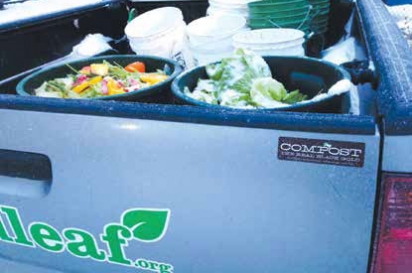Bringing in the Eats
Glean KY puts excess food where it’s most needed
It’s the busy season for Glean KY. Harvesters with the Lexington- based nonprofit that gathers and distributes fruit and vegetables to hungry Kentucky residents collected more than 2,000 pounds of apples and pears recently from an orchard in Bourbon County.
In one day.
“We get quite a bit from the local food system, especially this time of the year,” said Stephanie Wooten, Glean’s executive director. “Two thousand pounds in one day is not that unusual.”
While harvest season magnifies Glean’s mission, the organization works year-round to provide fresh produce to those in need — a vital service that intercepts perfectly fine fruit and vegetables that would otherwise end up in a landfill and contribute to a national food waste dilemma.
Of the estimated 40% of all food that goes to waste in the U.S., vegetables make up 19% and fruit 14%, ranking second and third, respectively, according to “The State of America’s Wasted Food,” a study by the Academy of Nutrition and Dietetics Foundation.
Enter Glean, which “gleaned” its one millionth pound of food in August. Not bad for an initiative that was started in 2010 by three people with the simple goal of attacking food waste and hunger.
“For us it’s really important and motivating that we’re able to address two problems at once,” Wooten said. “As a nonprofit we’re in a unique position that  literally the biggest thing that fuels our work is something that was thrown away.”
literally the biggest thing that fuels our work is something that was thrown away.”
Last year Glean made 618 gleaning trips to 38 sources, which included farms, orchard growers, farmers’ markets, grocers — “anywhere we can find it,” Wooten said.
“It’s important to us to make sure we’re only gleaning produce we would eat ourselves. We want to treat our recipients with integrity,” Wooten said. “There is a huge window of produce that is perfectly edible between what stores want to put on the shelf and what can be composted.”
More than 216,000 pounds of fruits and vegetables were distributed to 60 agencies across the Commonwealth last year through Glean. Fresh produce makes for healthier meals for food-insecure residents. Of the agencies Glean serves, 96% last year reported increased nutritional value from Glean’s fresh fruits and vegetables.
“They help out tremendously. They’re a blessing,” said Greg Smith, kitchen manager and cook at Lighthouse Ministries, which provides free meals to people in need along with housing for disadvantaged men and support with drug rehabilitation. “If it wasn’t for [Glean] I’d be short on a lot of stuff.”
Glean typically visits Lighthouse once a week—twice a week during harvest season. The fruit and vegetables “help me give them a full meal with all the nutrients they need,” said Smith, who serves between 70 and 120 people during lunch Monday through Saturday.
The nutritional aspect is not to be understated: Of the agencies Glean supported last year, 35% reported it was the first time they had ever served fresh produce.
“It’s shocking the percentage that are serving fresh produce for the first time,” said Wooten, adding that fruits and vegetables help the agencies stretch other ingredients further while increasing nutrition.
“Food is food when you’re in need,” Wooten added. “Fresh produce is particularly helpful when you’re nutrient-deficient.”
According to the Food and Agriculture Organization (FAO) of the United Nations, the largest category for food loss in the production phase is fruits and vegetables. It estimates that 20% of fruit and vegetable loss occurs during production, according to “The State of America’s Wasted Food.”
About 40% of Glean’s food comes from farms and orchards.
“When you see how much is thrown away on a daily basis—seeing it on piece of paper is one thing, but when you see it in front of you, when you’re physically hauling it to your vehicle, it’s unbelievable how much food is thrown away,” Wooten said. “Especially quality food.”
The organization has two requirements: that the food goes to people in need and that it’s not sold. And it doesn’t always go to organizations. Glean has a Neighborhood Ambassador Program in which food is distributed to residents’ front porches in some instances. In one case a woman who does laundry for a mobile home park takes fresh produce to its residents through Glean’s program.
Said Wooten of the gleaned food: “We just want people to use it.”
A New Kind of Carpool
Lexington food waste recycling program goes curbside Always on the lookout for a new revenue stream, nonprofit Seedleaf in Lexington has developed a unique program aimed at residential food waste recycling with the hope of turning a profit.
Compost Carpool is a curbside food recycling program in which Seedleaf picks up five-gallon buckets of food waste and shredded newspapers once a week from residents for a weekly fee of $15. A full bucket is picked up, and an empty one is dropped off.
The waste is placed in one of Seedleaf’s 10 low-tech static compost piles and after three months it’s spread in one of its 15 community gardens, or given away.
“It’s nothing we invented but it’s something we think we can get some traction out of here,” said Seedleaf Director Ryan Koch, adding that similar programs can be found in places like Charlottesville, VA, and Washington, DC.
The program, which has a handful of clients, was developed from Seedleaf’s pilot program with Lexington’s Division of Waste Management, in which the nonprofit picks up food waste from 32 restaurants in the city’s central sector that it then composts for use in the community gardens.
“We kept running into people wanting to try this at home,” Koch said, “and as a nonprofit we’re always looking for an income stream.”
While the money is a bonus, Koch takes pride in helping to cultivate a sustainable local food system.
“I’d love to empower people with the skills and know-how and confidence to take care of some of their food waste at home,” he said. “I have a vision for a decentralized food system and a decentralized waste management system.
“I think neighborhoods can work together and solve some of our biggest problems.”
WHAT’S IN A LABEL?
Confusion over date labeling leads to billions of pounds of food waste every year. Part of reducing waste is understanding the difference between:
- Sell-By: This label is for retailers to inform them of the date by which the product should be sold or removed from shelf life. This does not mean that the product is unsafe to consume after the date. Typically one-third of a product’s shelf-life remains after the sell-by date for the consumer to use at home.
- Use-By: For consumers, this label indicates the date by which the product should be eaten; mostly because of quality, not because the item will necessarily make you sick if eaten after the use-by date. However after the use-by date, product quality is likely to go down much faster and safety could be lessened.
- Best-By: This is a suggestion to the consumer on which date the product should be consumed to assure for ideal quality.
- Closed or coded dates: Packing numbers for use by the manufacturer.
Source: Bob Brackett, PhD, CFS, Director of the Institute for Food Safety and Health at the Illinois Institute of Technology






